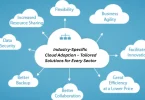Introduction
In today’s fast-paced digital world, businesses are constantly looking for ways to work smarter and faster. One of the biggest game-changers in 2025 is the use of AI and Automation in Cloud Services – Enhancing Efficiency in 2025. These technologies are helping companies save time, reduce costs, and improve accuracy by taking over repetitive tasks and making smart decisions automatically. From managing data to boosting security, AI and automation are making cloud services more powerful and efficient than ever before. In this blog, we’ll explore how this tech duo is transforming the cloud landscape and why it matters for the future of business.
What is AI and Automation in Cloud Services?

AI and Automation in Cloud Services refer to the use of smart technologies like artificial intelligence (AI) and automated tools to manage and optimize cloud-based systems.
- Artificial Intelligence (AI) allows cloud platforms to learn from data, make smart decisions, and solve problems without human input.
- Automation handles routine tasks like monitoring, backups, updates, and scaling—automatically and efficiently.
Together, these tools help cloud services run faster, smoother, and more reliably. Instead of waiting for manual action, systems can now adjust in real-time—fixing issues, improving performance, and even preventing downtime. This makes cloud services more intelligent and cost-effective for businesses in 2025.
You may also like it:
Cloud Compliance Requirements – Ensure Secure & Lawful Cloud Operations
Securing Multi-Cloud Environments – Strategies for Safer & Smarter Cloud Protection
Top Cloud Security Tools 2025 – Protect Your Data with Trusted & Powerful Solutions
Why AI and Automation in Cloud Services Are Important
Boosts Business Efficiency
Reduces Manual Workload: Automation handles repetitive tasks like updates and monitoring, allowing teams to focus on more important work.
- Faster Response Times: AI reacts to system issues in real time, reducing delays and keeping operations running smoothly.
- Improves Workflow Speed: Smart tools streamline processes, making services more responsive and productive.
Enhances Data Security
- 24/7 Threat Monitoring: AI constantly scans for unusual activity, helping detect threats before they cause harm.
- Automated Incident Response: The system can act instantly on alerts, stopping security breaches without human delay.
- Stronger Compliance Checks: Automation ensures regular audits and policy enforcement, reducing the risk of violations.
Cuts Operational Costs
- Smart Resource Allocation: AI ensures you’re only using the resources you need, preventing unnecessary spending.
- Minimized Downtime: Automated systems quickly fix common errors, reducing costly service outages.
- Reduced IT Staffing Needs: Fewer manual tasks mean businesses can manage more with smaller teams.
Supports Scalability and Growth
- Automatic Scaling: Resources increase or decrease based on demand, helping businesses grow without interruptions.
- Handles High Traffic Loads: Automation balances loads smoothly, even during peak usage times.
- Adaptable Infrastructure: AI helps systems adjust as business needs change, supporting long-term growth.
Improves Decision-Making
- Real-Time Analytics: AI provides instant insights from data, supporting faster and smarter business decisions.
- Predictive Analysis: It can forecast trends, helping companies prepare for future demands or issues.
- Data-Driven Strategies: Businesses rely on accurate, AI-powered insights to guide planning and innovation.
Step-by-Step Guide to AI and Automation in Cloud Services

Step 1: Assess Business Needs
- Start by identifying which areas of your cloud infrastructure need improvement. Look for tasks that are repetitive, time-consuming, or prone to human error.
Step 2: Choose the Right Cloud Provider
- Select a cloud service provider (like AWS, Azure, or Google Cloud) that offers strong AI and automation features. Compare their tools, pricing, and scalability.
Step 3: Define Clear Goals
- Set clear objectives—such as reducing downtime, improving speed, or enhancing security—so you can measure the impact of AI and automation accurately.
Step 4: Integrate AI and Automation Tools
- Use built-in AI tools or third-party solutions to automate tasks like data management, server scaling, or threat detection. Start small and expand gradually.
Step 5: Automate Routine Operations
- Automate tasks such as system backups, updates, log monitoring, and resource allocation to reduce human effort and ensure consistency.
Step 6: Use AI for Data Insights
- Leverage AI to analyze customer behavior, system performance, and operational trends. These insights help with smarter decision-making and forecasting.
Step 7: Implement Security Automation
- Deploy AI-driven security tools to monitor threats, block attacks, and maintain compliance. This boosts cloud safety and reduces response times.
Advantages and Disadvantages of AI and Automation in Cloud Services
| Advantages | Disadvantages |
| Improved Efficiency Automated processes save time by reducing manual work, speeding up operations, and ensuring consistency across cloud tasks. | High Initial Costs Implementing AI and automation tools may require a significant upfront investment in software, integration, and skilled professionals. |
| Cost Savings By optimizing resource usage and minimizing errors, businesses can cut down on unnecessary expenses and operational costs. | Complex Setup Integrating AI with existing cloud infrastructure can be technically complex and may require expert knowledge and planning. |
| Real-Time Monitoring AI tools offer instant visibility into cloud performance, helping detect and resolve issues before they impact services. | Skill Gap There is a shortage of professionals with the expertise to manage and maintain AI-powered cloud systems effectively. |
| Scalability AI and automation make it easy to scale resources up or down automatically based on user demand or workload needs. | Over-Reliance on Automation Too much automation can reduce human oversight, increasing the risk of unnoticed system failures or misconfigurations. |
| Enhanced Security AI-driven security systems detect threats quickly and respond in real time, reducing the chances of breaches and data loss. | Data Privacy Concerns AI systems access and analyze vast amounts of data, which can raise concerns about privacy, compliance, and ethical use. |
You may also like it:
Cloud Security Best Practices 2025 – Protect Your Data with Smarter & Safer Strategies
Real-Time Data Processing with AI – Faster Insights & Smarter Decisions
Top Benefits of AI Cloud Integration – Smarter Faster & Scalable Business Solutions
Frequently Asked Questions (FAQs)
What is AI in cloud services?
AI in cloud services means using smart systems that can learn, analyze data, and make decisions to improve how cloud platforms work.
How does automation help in cloud computing?
Automation takes care of routine tasks like backups, updates, and scaling, so things run smoothly without needing constant manual work.
Is it expensive to use AI and automation in the cloud?
It can cost more at the start, but over time, it saves money by reducing errors, speeding up tasks, and using resources more efficiently.
Can small businesses use AI and automation in the cloud?
Yes, many cloud providers offer tools that are easy to use and affordable, making it possible even for small businesses to benefit.
Does automation replace IT staff?
No, it doesn’t replace people but helps them work better by reducing boring, repetitive jobs so they can focus on bigger tasks.
Is AI in cloud services secure?
Yes, most AI tools come with built-in security features, and many help detect threats faster than humans can.
What cloud providers support AI and automation?
Popular cloud platforms like AWS, Microsoft Azure, and Google Cloud all offer strong AI and automation tools in 2025.
Conclusion
AI and Automation in Cloud Services are changing the way businesses work in 2025. They make cloud systems faster, smarter, and more efficient by handling tasks automatically and providing real-time insights. Whether you’re a small business or a large company, using these tools can save time, reduce costs, and improve security. Now is the perfect time to explore how AI and automation can make your cloud operations better and easier to manage.
Bonus Points
- AI-Powered Chatbots for Support: Many cloud platforms now include AI chatbots that provide 24/7 customer support, reducing the need for large support teams.
- Predictive Maintenance: AI helps identify hardware or software issues before they cause downtime, allowing for proactive fixes and uninterrupted service.
- Green Cloud Computing: AI optimizes energy use in cloud data centers, helping companies reduce their carbon footprint and operate more sustainably.
- Faster Disaster Recovery: Automation ensures data is backed up regularly and restores systems quickly in case of failure or cyberattacks.
- Seamless Integration with IoT: AI-driven cloud platforms work well with IoT devices, enabling real-time data processing and smarter automation at the edge.
- Personalized User Experiences: Businesses can use AI in the cloud to deliver personalized content, product recommendations, or services to customers.
- Auto-Compliance Reporting: Automation simplifies the process of meeting industry
You may also like it:
AI-Driven Cloud Analytics – Smarter Data Insights for Modern Businesses
Intelligent Cloud Platforms – Smart Scalable & Secure Computing Solutions
Top Cloud-Based Machine Learning Tools in 2025 – Features Benefits & Use Cases
AI in Cloud Computing 2025 – Latest Trends Innovations & Future Insights




